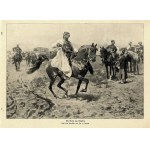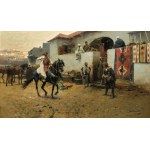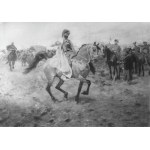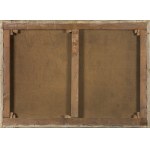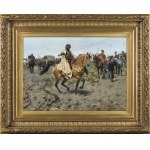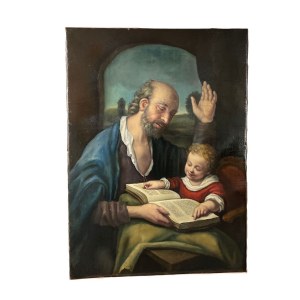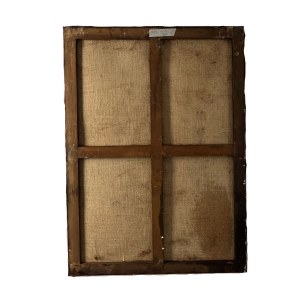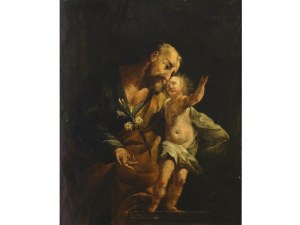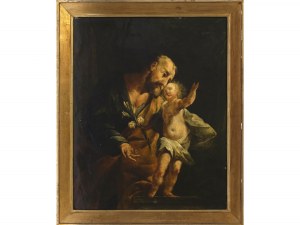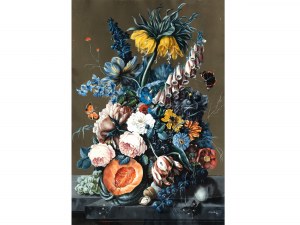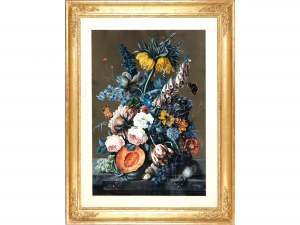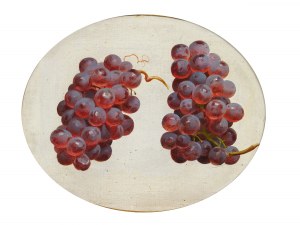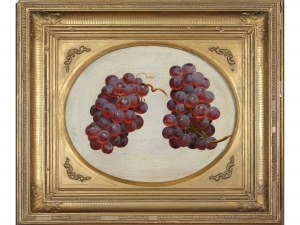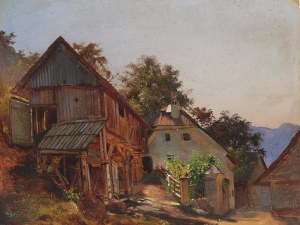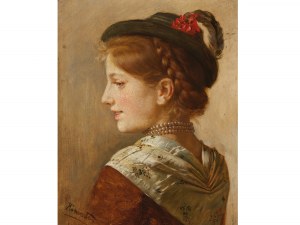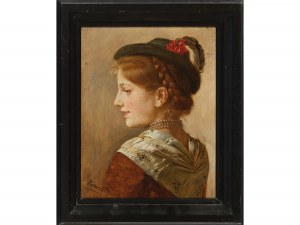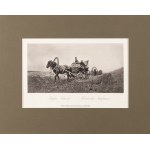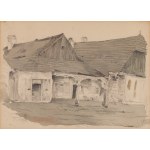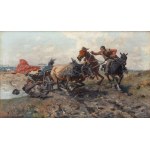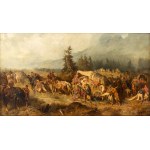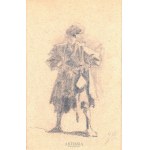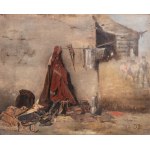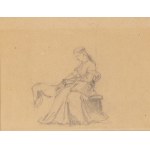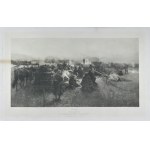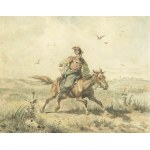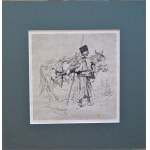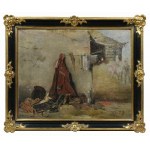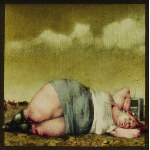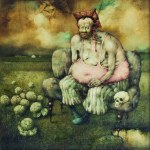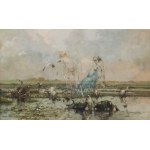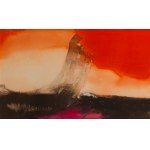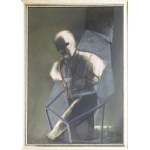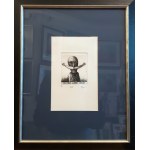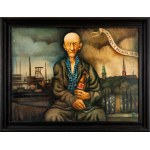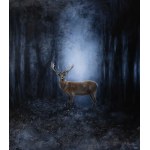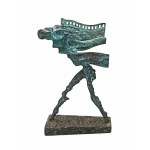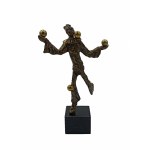67,5 x 93,5cm - oil, canvas Alternative title: DIE PERLE DES GESTÜTS. ARABCZYK
signature p.d.: Jozef Brandt | from Warsaw | Munich
Signed l.d.: JB [tied monogram].
Attached to the painting is an appraisal by Dr. Mariusz Klarecki dated January 2023, which we quote extensively below.
The painting style, the colors, the drawing of the figures, the accessories shown in the painting, the way the horse is painted all testify indisputably to the painterly skill of Jozef Brandt.
Pearl of the Stud combines Brandt's love of horses, the Orient and borderland travel. The scene takes place at a horse market, somewhere in the 17th-century Borderlands of the former Republic. In the foreground we see a magnificent steed being ridden by an Oriental horseman. What draws attention is not only the shiny coat of the buff-colored mount, but also its decorative harness, with golden collar and saddle and red thongs. The bearded rider is clad in a richly embroidered vest and ornate boots. His head is tied with a shawl and his shoulders are covered with a white coat of sheep's wool, the matter of which has been exquisitely rendered by the artist with the texture of paint. To the left, we see another dark-skinned rider, tied at the waist with a red cloth, riding a bay horse. The other figure, wearing a spread cap, is leading a bay horse. Behind them can be seen a fragment of a market with a large number of horses and a cart covered with a colorful kilim. To the right of the title stud pearl, in turn, we see three Polish noblemen. The first of them, clad in a red kontusz, is riding a dark-brown horse. Next to him is shown sideways a rider wearing a dark blue kontusz and boots with light, almost yellow uppers, with a saber at his side, riding a derringer horse. Next to him, we barely notice a black horse, ridden by a nobleman in a light-colored cloak and decorative headdress. Standing by the horse-riding nobleman is a dark-skinned salesman in a blue-gray robe, with decorative light-colored shoes on his feet. He is extolling the stud pearl, which Polish horsemen are already clearly fascinated by. Further on we see the tents of the encampment and the horses tied up. Attention is drawn to a sign suspended above the tents, probably a tied clump of hay, indicating the direction of the wind - an accessory that Brandt liked to show in his paintings depicting fairs.
Several of Brandt's paintings are known to depict scenes of merchants at the market, merchants laden with eastern carpets and crockery, as well as unusually dynamic depictions of tabunas of horses being herded to a horse fair. In the only one of these paintings, which is a self-portrait confirmed in the sources, the painter depicted himself at the market in Balta. This town, located on the Polish-Turkish border, was for the artist a symbol of the meeting of two cultures - Oriental and European. A place where merchants, soldiers and residents of the Wild Fields (Borderlands), followers of Islam and Christians met at colorful fairs. In the painting Jarmark in Balta, Brandt appears in old Polish costume with a cornet on his head. He participates in the transaction by bargaining with an Eastern merchant for a selected saddle.
Just as in Jarmark in Balta, sold at the Agra auction, in the work Pearl of the Stud, Brandt depicted a scene from everyday life in the 17th-century Borderlands of the former Republic. The artist focused the viewer's attention not only on the interesting story, numerous decorative details, but also on the realistic depiction of the encampment, probably a multi-day horse fair. The painting impresses with the variety of Eastern paraphernalia, costumes, weapons and armaments depicted. The painterly props we find in this and his other paintings come from the excellent collection of old weapons and costumes, as well as military ordnance of the horseman and horse, that Jozef Brandt amassed. The collection, which was created throughout his life and contains outstanding relics of old artistic craftsmanship, was donated to the National Museum in Warsaw by the will of the artist (it is now in the collection of the Museum of the Polish Army in Warsaw).
Brandt took his passion for depicting the horse from his first painting teacher, Juliusz Kossak. Soon the artist developed his own style, and the horse and knight became the main characters. The painter, an excellent horseman and owner of a well-known and respected stud farm, was well versed in both the structure and movement of the horse. It was an animal very close to him, perfectly familiar, treated with deep affection - hence the artist illustrated horse fairs, horse grazing, as well as skirmishes and battles involving cavalry with true passion and exceptional skill.
Jozef Brandt's paintings were extremely popular from the beginning of his career. Starting in the 1880s, the artist sold his paintings sometimes even before they were completed. For this reason, repetitions of motifs are encountered, enjoying particular popularity. However, the artist completely changed the composition of the painting each time. Among such works is The Arabian, created in 1890-1891. In the foreground, Brandt repeated the Arabian horseman in a similar, but not identical, shot as in Pearl of the Stud. The environment of the rider was completely changed - the artist moved the scene to a borderland town. At the same time he composed the supporting characters completely differently.
The presented picture was painted in the painter's Munich studio. Brandt spent warm spring days and summers in the Polish country estate of Orońsko near Radom or traveling in the Borderlands of the former Republic of Poland. In late autumn and winter he painted in his studio in Munich, using pencil sketches and photographs taken from Poland. The free way of writing the signature in three rows, the typeface and the content-Jozef Brandt | from Warsaw | Munich-are characteristic of the late 1880s and early 1890s. With the addition of Warsaw, Brandt emphasized his Polish origin and national identity, at a time when the territory of the former Republic was under partition.
An interesting trick of the author is the issue of the double signature on the painting. At first we notice the full, developed signature located in the lower right corner. On closer inspection, one can see the monogram JB in the lower left corner of the painting. Similar instances, rare but did occur in the works of Jozef Brandt. It is likely that the author initially intended to sell a sketch-painted picture, signed only with a monogram. It should be remembered that this was a period of great success for the artist. Letters from that time are preserved, when Joseph Brandt refuses to allow one of the Munich galleries to make his paintings available for exhibition, because all of his works sell immediately after painting, and many are pre-dated even before painting. Probably due to his haste, the author of the painting intended to sell a sketchily painted canvas, provided with an abbreviated monogram. It is not known for what reasons the artist changed his mind and decided to carefully finish the composition; perhaps he received more time from the commissioning party or simply changed his mind. Regardless of these motivations, which we will never know, the double signature treatment is an interesting story related to the creation of the work.
In conclusion, I consider the painting by Jozef Brandt, entitled Pearl of the Stud, presented to me for review, to be an authentic work created around 1891. The painting has an interesting composition, the protagonist of which is a horse, an animal so well known and close to the painter. The whole scene was depicted by the author at a borderland horse fair of the former 17th century Republic. The two signatures on the painting belong to typical Joseph Brandt signatures from the period of the painting's creation and were applied by the artist's hand. The painting comes from a very good period of his career, when the painter reached the fullness of his artistic abilities and gained great success in Europe and North America with his work. The stud pearl is an interesting painting, which has added value by the fact that it has not been recorded anywhere on the auction market since its publication in "Gartenlaube" in 1901. Rediscovered, it is sure to gain great public interest.
(from the expert opinion of Dr. Mariusz Klarecki)
Bibliography:
- "Gartenlaube" 1901, no. 43, il. on p. 297;
- "Family Chronicle" 1903, no. 12, p. 288, il. on p. 284;
- "Family Chronicle" 1912, no. 25, il. on p. 389;
- Bogdan Zakrzewski, Sienkiewicz and Brandt, typescript, doctoral thesis prepared under the direction of Prof. Roman Pollak, Department of Polish Philology, Adam Mickiewicz University in Poznań, Poznań 1947, p. 168 [image listed in Aniela Daszewska's inventory];
- Tomasz Adam Pruszak, The Pearl of Jozef Brandt's Stud, "Gazeta Antykwaryczna" 2007, no. 6, p. 34;
- Ewa Micke-Broniarek, Genre themes in Józef Brandt's painting/Genre themes in Józef Brandt's painting [in:] Józef Brandt (1841-1915). Between Munich and Orońsko/ Between Munich and Orońsko, edited by Monika Bartoszek, Orońsko 2015, p. 13;
- Ewa Micke-Broniarek, Józef Brandt 1841-1915, National Museum in Warsaw, Warsaw 2018, p. 213;
Archives:
Pruszak family archives, collection of Maciej Stachura, Inventory of paintings by Jozef Brandt [painted until 1908], rkps, item 106; Inventory of photographs of paintings by Brandt [painted until 1908], rkps, p. 2.
Józef Brandt (Szczebrzeszyn 1841 - Radom 1915) was one of the most outstanding Polish battle painters. He began his painting studies in Warsaw under the tutelage of Juliusz Kossak. In 1858-1860 he was in Paris, where he took up engineering studies. However, he soon abandoned them in favor of painting and trained in the studio of Leon Cogniet. After returning to Poland, he made his debut in 1861 at an exhibition at Warsaw's TZSP. From 1863 he continued his studies at the Munich Academy of Fine Arts under Franz Adam. In 1870 he opened his own atelier in Munich and soon became the leader, the "general" of the Polish art colony there and a teacher of many painters. After 1877, he spent the summer months in Oronsko, inviting a group of his students for plein-air sessions.
He became an honorary professor at the Academy in Munich (1878), a member of the Academy in Berlin (1877) and Prague (1900). Decorated with high orders, awarded medals and prizes at international exhibitions, he enjoyed a truly European fame. Living and creating outside the country, he always clearly emphasized his Polishness; expressing it, for example, by signing his paintings Jozef Brandt of Warsaw.
He painted battles, skirmishes, drive-ins - episodes from the history of the Polish borderland wars and the Swedish wars of the 17th century, as well as genre scenes - horsemen, hunting, fairs. His colorful, full of movement and workshop-perfect paintings were widely admired as the best example of the then highly regarded "Polish school." But while the German or French viewer saw in them primarily the exoticism and colors of the Orient, for Poles they were canvases "real, natural, familiar like excerpts from the diaries of Pasek or Rzewuski, transposed into colors and lines."
Recently viewed
Please log in to see lots list
Favourites
Please log in to see lots list




